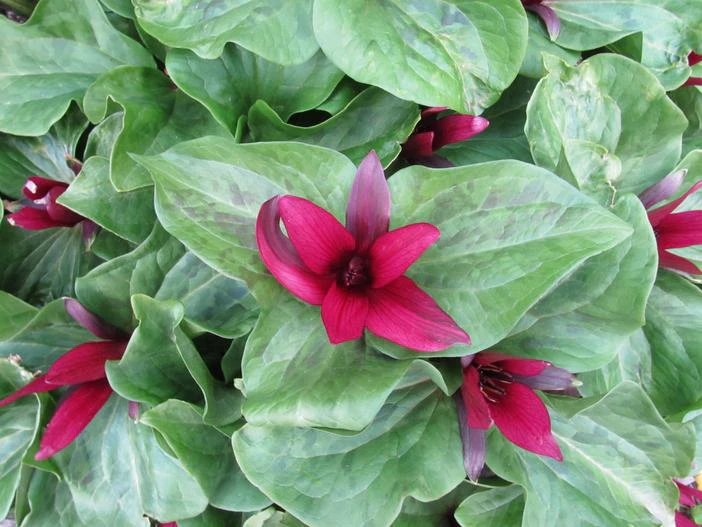Giant Wakerobin
(Trillium chloropetalum var. giganteum)
Giant Wakerobin (Trillium chloropetalum var. giganteum)
/
/

WhiteTimberwolf
CC0
Image By:
WhiteTimberwolf
Recorded By:
Copyright:
CC0
Copyright Notice:
Photo by: WhiteTimberwolf | License Type: CC0 | License URL: http://creativecommons.org/publicdomain/zero/1.0/deed.en | Uploader: WhiteTimberwolf | Publisher: Wikipedia Commons
















Estimated Native Range
Climate Requirements
| • Precipitation | 29" - 35" |
| • High Temp. | 70°F - 85°F |
| • Low Temp. | 37°F - 43°F |
Summary
Trillium chloropetalum var. giganteum, commonly known as Giant Wakerobin, is a deciduous perennial herb native to the rich, moist, deciduous and mixed evergreen forests of Northern California. It typically grows to a height and width of 1-2 feet (0.3-0.6 meters). The plant is noted for its mottled leaves and large, showy flowers that can vary in color from brown, yellow, green, purple to red, blooming in early spring. The flowers are often followed by berry-like capsules that provide food for wildlife.
Giant Wakerobin is valued for its striking flowers and is used in woodland gardens, shade gardens, and native plant landscapes. It is a low-maintenance plant that adds a dramatic touch to shaded areas. While it prefers humus-rich, well-drained soil, it is adaptable to a range of soil conditions as long as adequate moisture is provided. It is best grown in part shade to full shade and requires consistent moisture during the growing season. Over-collection and habitat destruction have led to its decline in the wild, making cultivation in gardens increasingly important for its conservation.CC BY-SA 4.0
Giant Wakerobin is valued for its striking flowers and is used in woodland gardens, shade gardens, and native plant landscapes. It is a low-maintenance plant that adds a dramatic touch to shaded areas. While it prefers humus-rich, well-drained soil, it is adaptable to a range of soil conditions as long as adequate moisture is provided. It is best grown in part shade to full shade and requires consistent moisture during the growing season. Over-collection and habitat destruction have led to its decline in the wild, making cultivation in gardens increasingly important for its conservation.CC BY-SA 4.0
Plant Description
- Plant Type: Herb
- Height: 1-2 feet
- Width: 1-2 feet
- Growth Rate: Slow
- Flower Color: Brown, Purple
- Flowering Season: Spring
- Leaf Retention: Deciduous
Growth Requirements
- Sun: Part Shade, Full Shade
- Water: Medium
- Drainage: Medium, Fast
Common Uses
Bee Garden, Deer Resistant, Fragrant, Low Maintenance
Natural Habitat
Rich, moist, deciduous and mixed evergreen forests of Northern California
Other Names
Common Names:
Scientific Names: Trillium chloropetalum var. giganteum, Trillium sessile var. californicum, Trillium sessile var. giganteum, Trillium giganteum, Trillium chloropetalum subsp. giganteum, Trillium sessile f. californicum, Trillium sessile subsp. giganteum
GBIF Accepted Name: Trillium chloropetalum var. giganteum (Hook. & Arn.) Munz